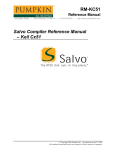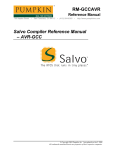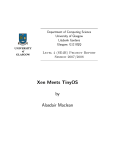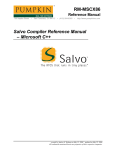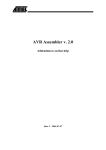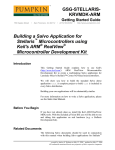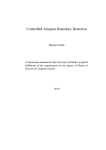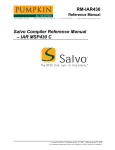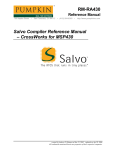Download RM-ICCAVR Salvo Compiler Reference Manual
Transcript
RM-ICCAVR
Reference Manual
750 Naples Street
•
San Francisco, CA 94112
• (415) 584-6360
•
http://www.pumpkininc.com
Salvo Compiler Reference Manual
– ImageCraft ICCAVR
© Copyright 2003 Pumpkin, Inc. last updated on Jun 5, 2008
All trademarks mentioned herein are properties of their respective companies.
Reference Manual
Introduction
This manual is intended for Salvo 4 users who are targeting Atmel
(http://www.atmel.com/)
AVR®
and
MegaAVR™
1
microcontrollers with ImageCraft's (http://www.imagecraft.com/)
ICCAVR C compiler v7.14 or later.
Note Users of ICCAVR v6 and earlier should use Salvo v3.x,
which is now deprecated.
Related Documents
The following Salvo documents should be used in conjunction
with this manual when building Salvo applications with
ImageCraft's ICCAVR C compiler:
•
Salvo User Manual
Example Projects
Example Salvo projects for use with ImageCraft's ICCAVR C
compiler and the ImageCraft IDE can be found in the:
\Pumpkin\Salvo\Example\AVR\
directories of every Salvo for Atmel AVR and MegaAVR
distribution.
Tip These example projects can be easily modified for any AVR
or MegaAVR device.
Features
Table 1 illustrates important features of Salvo's port to
ImageCraft's ICCAVR C compiler.
2
RM-ICCAVR Salvo Compiler Reference Manual – ImageCraft ICCAVR
Reference Manual
General
Abbreviated as
ICCAVR
Salvo Lite, LE & Pro
for Atmel AVR and MegaAVR
entire AVR and MegaAVR family
salvoporticcavr.h
salvoporticcavr.s,
salvoporticcatmega.s,
salvoporticcatm256.s
Available distributions
Supported targets
Header file(s)
Other target-specific file(s)
salvocfg.h
Compiler auto-detected?
Include target-specific header file
in salvocfg.h?
yes
2
yes
libraries
Lib\ICCAVR-v7
(for v7.x compilers)
Located in
Context Switching
function-based via
OSDispatch() & OSCtxSw()
no
total size must not exceed 254 8-bit
bytes
Method
Labels required?
Size of auto variables and
function parameters in tasks
Memory & Registers
Internal and external RAM
supported?
R20..R23 used?
yes, via
-bsalvoram:0xstart.0xend
no
Interrupts
Interrupt latency in context
switcher
Interrupts in critical sections
controlled via
Default behavior in critical
sections
0 cycles
user hooks
see example user hooks
Debugging
Source-level debugging with Pro
library builds?
yes
Compiler
Bitfield packing support?
printf() / %p support?
va_arg() support?
no
yes / yes
yes
Table 1: Features of Salvo port to ImageCraft's ICCAVR
C compiler
Libraries
Nomenclature
The Salvo libraries for ImageCraft's ICCAVR C compiler follow
the naming convention shown in Figure 1.
RM-ICCAVR Salvo Compiler Reference Manual – ImageCraft ICCAVR
3
Reference Manual
libsalvoficcavr-a.a
Salvo library
type
f: freeware
l: standard
ImageCraft
C Compiler
target
avr:
AVR
atmega: MegaAVR
configuration
a: multitasking with delays and events
d: multitasking with delays
e: multitasking with events
m: multitasking only
s: Salvo SE library
t: multitasking with delays and events,
tasks can wait with timeo
y: Salvo tiny library
option
-: no option
i: library includes debugging information
Figure 1: Salvo Library Nomenclature – ImageCraft's
ICCAVR C Compiler
Type
Salvo Lite distributions contain freeware libraries. All other Salvo
distributions contain standard libraries. See the Libraries chapter of
the Salvo User Manual for more information on library types.
Target
Each library is intended for one or more specific processors. Table
2 lists the correct library for each AVR and MegaAVR processor.
4
RM-ICCAVR Salvo Compiler Reference Manual – ImageCraft ICCAVR
Reference Manual
Target Code
avr:
atmega:
atm128:
atm256:
Processor(s)
AVR and megaAVR devices with
8KB or less program memory
(e.g. AT90S8515). These libraries
use the basic AVR instruction set.
AVR and megaAVR devices with
more than 8KB and less than 256KB
of program memory (e.g.
ATmega16). These libraries use the
megaAVR instruction set.
AVR and megaAVR devices with
more than 8KB and less than 256KB
of program memory (e.g.
ATmega1280). These libraries use
the enhanced AVR instruction set.
megaAVR devices with 256KB or
more of program memory
(e.g. ATmega2561). These libraries
use the extended AVR instruction
set.
Table 2: Processors for Salvo libraries – ImageCraft's
ICCAVR C compiler
Note The target code for an unlisted processor will match that
used by ImageCraft's ICCAVR C compiler for standard libraries,
etc.
Option
Salvo Pro users can select between two sets of libraries – standard
libraries, and standard libraries incorporating source-level
debugging information. The latter have been built with
ImageCraft's ICCAVR C compiler's +g command-line option. This
adds source-level debugging information to the libraries, making
them ideal for source-level debugging and stepping in the
ICCAVR debugger. To use these libraries, simply select one that
includes the debugging information (e.g. libsalvoliccavrit.a)
instead of one without (e.g. libsalvoliccavr-t.a) in your
ICCAVR project.
Configuration
Different library configurations are provided for different Salvo
distributions and to enable the user to minimize the Salvo kernel's
footprint. See the Libraries chapter of the Salvo User Manual for
more information on library configurations.
RM-ICCAVR Salvo Compiler Reference Manual – ImageCraft ICCAVR
5
Reference Manual
Build Settings
Salvo's libraries for ImageCraft's ICCAVR C compiler are built
using the default settings outlined in the Libraries chapter of the
Salvo User Manual. Target-specific settings and overrides are
listed in Table 3.
Target-specific Settings
Delay sizes
Idling hook
Interrupt hook
Watchdog hook
System tick counter
Task priorities
8 bits
dummy,
can be overridden
disables then restores GIE bit,
can be overridden
clears WDT without other changes,
can be overridden
available, 32 bits
enabled
Table 3: Build settings and overrides for Salvo libraries
for ImageCraft's ICCAVR C compiler
Note Salvo Lite libraries have precompiled limits for the number
of supported tasks, events, etc. Salvo LE and Pro libraries have no
such limits. See the Libraries chapter of the Salvo User Manual for
more information.
Available Libraries
There are a total of 44 Salvo libraries for ImageCraft's ICCAVR C
compiler. Each Salvo for Atmel AVR and MegaAVR distribution
contains the Salvo libraries of the lesser distributions beneath it.
Target-Specific Salvo Source Files
Depending on the target AVR, one of three different contextswitcher files is required for Salvo Pro source-code builds, as
shown in Table 4:
Context-switcher Filename
salvoporticcavr.s
salvoporticcatmega.s
salvoporticcatm256.s
6
Application
AVRs with 8KB or less program
memory. Uses IJMP and RJMP
instructions.
AVRs with more than 8KB and up to
128KB program memory. Uses IJMP
and JMP instructions.
AVRs with 256KB and more program
memory. Uses EIJMP, JMP and LPM
3
instructions.
RM-ICCAVR Salvo Compiler Reference Manual – ImageCraft ICCAVR
Reference Manual
Table 4: Target-specific context-switcher files for
ImageCraft's ICCAVR C compiler
salvocfg.h Examples
Below are examples of salvocfg.h project configuration files for
different Salvo for Atmel AVR and MegaAVR distributions
targeting a variety of AVR targets.
Salvo Lite Library Build
#define
#define
#define
#define
#define
#define
#define
OSUSE_LIBRARY
OSLIBRARY_TYPE
OSLIBRARY_CONFIG
OSTASKS
OSEVENTS
OSEVENT_FLAGS
OSMESSAGE_QUEUES
TRUE
OSF
OST
2
4
0
1
Listing 1: Example salvocfg.h for library build using
libsalvoficcavr-t.a
Salvo LE & Pro Library Build
#define
#define
#define
#define
#define
#define
#define
OSUSE_LIBRARY
OSLIBRARY_TYPE
OSLIBRARY_CONFIG
OSTASKS
OSEVENTS
OSEVENT_FLAGS
OSMESSAGE_QUEUES
TRUE
OSL
OST
7
13
3
2
Listing 2: Example salvocfg.h for library build using
libsalvoliccatmega-t.a or libsalvoliccatm256.a
Salvo Pro Source-Code Build
#define
#define
#define
#define
#define
#define
OSENABLE_IDLING_HOOK
OSENABLE_SEMAPHORES
OSTASKS
OSEVENTS
OSEVENT_FLAGS
OSMESSAGE_QUEUES
TRUE
TRUE
9
17
2
4
Listing 3: Example salvocfg.h for source-code build
RM-ICCAVR Salvo Compiler Reference Manual – ImageCraft ICCAVR
7
Reference Manual
Interrupt Latencies
Since Salvo's context switcher for ImageCraft's ICCAVR C
compiler does not need to control interrupts, Salvo applications can
easily be created with zero total interrupt latency for interrupts of
interest.
In a properly-configured application, only those interrupts that call
Salvo services will (by necessity) experience interrupt latency from
Salvo's operations. Users must ensure that these interrupt sources
are disabled (and re-enabled) via the user interrupt hooks.
Disabling and re-enabling interrupts globally in the user interrupt
hooks (i.e., the default user interrupt hook behavior) is of course
permitted, but will result in non-zero interrupt latencies for all
interrupt sources, even those that do not call Salvo services. See
the target-specific source files of this distribution for examples.
Memory Usage
Example Application4
Program
Memory Usage5
Data Memory
Usage6
\AVR\AT90S8515\…\tut5lite
\AVR\AT90S8515\…\tut5le
\AVR\AT90S8515\…\tut5pro
3206
3148
2962
57
57
56
Table 5: ROM and RAM requirements for Salvo
applications built with ImageCraft's ICCAVR C compiler
User Hooks
Overriding Default Hooks
In library builds, users can define new hook functions in their
projects and the linker will choose the user function(s) over the
default function(s) contained in the Salvo library.
In source-code builds, users can remove the default hook file(s)
from the project and substitute their own hook functions.
Idling
The default idling hook in salvohook_idle.c is a dummy
function, as shown below.
8
RM-ICCAVR Salvo Compiler Reference Manual – ImageCraft ICCAVR
Reference Manual
void OSIdlingHook ( void )
{
;
}
Listing 4: Default Salvo idling hook for ImageCraft's
ICCAVR C compiler
Users can replace it (e.g. with a directive to put the AVR to sleep)
by building their own version with their application.
Interrupt
The default interrupt hooks in salvohook_interrupt.c are
shown below.7
static unsigned char sreg;
void OSDisableHook(void)
{
unsigned char sreg_local;
sreg_local = SREG;
_CLI();
sreg = sreg_local;
}
void OSEnableHook(void)
{
SREG = sreg;
}
Listing 5: Default Salvo interrupt hooks for ImageCraft's
ICCAVR C compiler
These functions clear the GIE bit (i.e. disable global interrupts)
across Salvo's critical section, and restore the bit to its previous
value thereafter. These hooks are suitable for all applications.
These hooks work very well within Salvo services called from
interrupts, as the GIE bit is automatically cleared upon entry to an
interrupt. Therefore interrupts are not re-enabled at the end of a
Salvo service that is called in an ISR. This avoids unnecessary
interrupt nesting. The use of the auto variable sreg_local avoids
issues that would affect the shared global sreg when a Salvo
service is called from within an ISR.
Note Not disabling all source of interrupts that call Salvo services
during critical sections will cause the Salvo application to fail.
RM-ICCAVR Salvo Compiler Reference Manual – ImageCraft ICCAVR
9
Reference Manual
Watchdog
The default watchdog hook in salvohook_wdt.c is shown below.8
void OSClrWDTHook ( void )
{
_WDR();
}
Listing 6: Default Salvo watchdog hook for ImageCraft's
ICCAVR C compiler
Users can replace it (e.g. with a dummy function – this would stop
Salvo from clearing the watchdog timer and allow the user to clear
it elsewhere) by building their own version with their application.
Compiler Issues
Runtime Models and Compatible Libraries
The runtime models used by ImageCraft's ICCAVR C compiler
have evolved over the years. When building an application with
Salvo libraries, it's necessary to link to the libraries compatible
with the version of ImageCraft's ICCAVR C compiler that you are
using. Table 6 lists the locations of Salvo libraries as a function of
the ImageCraft's ICCAVR C compiler version.
ICCAVR Version
Salvo Library Location
7.x
Lib\ICCAVR-v7
Table 6: Compiler versions, runtime models and Salvo
library locations for ImageCraft's ICCAVR C compiler
Incompatible Optimizations
There are no known incompatibilities between ImageCraft's
ICCAVR C compiler’s optimizations (e.g. -O8, -O16, -O24) and
Salvo.
Special Considerations
ATmega2560/2561 (256KB and greater program memory)
In order to support the larger-than-16-bit program memory space
of the ATmega2560/2561 and similar megaAVRs, Salvo uses 4
10
RM-ICCAVR Salvo Compiler Reference Manual – ImageCraft ICCAVR
Reference Manual
bytes per function pointer instead of two.9 This allows Salvo tasks
to be located anywhere in program memory.
Salvo for AVR and megaAVR automatically detects whether you
are building for the ATmega2560 or ATmega2561, and configures
Salvo’s function pointer type accordingly. If you are using a chip
other than the ATmega2560 or ATmega2561, define the symbol
OSAVR_256K for every Salvo source module (including
salvomem.c in Salvo library builds). This can be done by passing
–DOSAVR_256K
to the compiler (e.g. in the AVR Studio IDE), or by including
#define OAVR_256K 1
in the project’s salvocfg.h.
Stack Issues
ImageCraft's ICCAVR C compiler uses two separate stacks – one
for return addresses (the hardware stack, which uses SP) and one
for parameter passing and local storage (the software stack, which
uses Y).
Compared to a non-Salvo, non-multitasking application with
similar call trees, the corresponding Salvo application will require
an additional two return addresses (i.e. 4 bytes for typical AVRs
and megaAVRs) in the hardware stack.10
The size of the hardware stack can be set in the ICCAVR IDE via
Project → Options → Target → Advanced → Return Stack
Size or on the iccavr linker command line, e.g.:
iccavr … -dhwstk_size:20 …
Applications using nested interrupts, floating points or longs will
require a hardware stack larger than the default size – see ICCAVR
Help for more information.
External SRAM
Salvo's global objects11 can be placed in internal or external RAM.
In ImageCraft's ICCAVR IDE, the placement of objects (e.g.
variables) in the data program area is controlled via Project →
Options → Target → Device Configuration (Internal SRAM),
RM-ICCAVR Salvo Compiler Reference Manual – ImageCraft ICCAVR
11
Reference Manual
etc. On the iccavr linker command line, placement of these
objects is specified via –bdata:start.end, e.g.:
iccavr … -bdata:0x260.0xffff …
specifies that the data program area start at 0x260 (the end of
internal SRAM) and extend to 0xFFFF (the 64K boundary).
Salvo's global objects can be placed – as a group – anywhere in
RAM (internal or external) by specifying the start and end
addresses of the salvoram program area. This applies to sourcecode and library builds. For example, to place all of Salvo's global
objects in a 256-byte block of external RAM just beneath the 32K
boundary, use
iccavr … -bsalvoram:0x7F00.0x7FFF …
when linking your application.12
Note If you do not use the –b linker command-line argument, the
program area will be located immediately after the bss
program area in the data program area. Therefore it is only
required if you wish to locate Salvo's global objects separately
from your program's variables, etc. You can override the order of
the program areas by using the .area assembler directive.
salvoram
Data Segments
The RAMPD register is normally used to access the entire data space
on processors with more than 64K bytes data space. There are no
provisions for accessing Salvo's global objects outside of the
current data segment of 64K bytes.
Code Compressor
Salvo is compatible with ImageCraft's ICCAVR
Compressor13 in both library- and source-code builds.
Code
Indirect Function Calls
Salvo handles indirect function calls directly through IJMP and
EIJMP instructions, and not through Code Compressor’s xicall.
This is transparent to the user.
12
RM-ICCAVR Salvo Compiler Reference Manual – ImageCraft ICCAVR
Reference Manual
Registers R20..R23
ICCAVR can be instructed to not use registers R20..R23. In
practice, this has little effect on the Salvo code – it may result in a
small speedup and smaller ROM size.
The Salvo libraries are built without using R20..R23 so that control
of these registers is left to the programmer.14
Salvo Pro users can control the use of these registers in a sourcecode build.
1
2
3
4
5
6
7
8
9
10
11
12
13
14
tinyAVR devices are not supported because of their lack of RAM.
This is done automatically through the __IMAGECRAFT__ and _AVR symbols
defined by the compiler.
ICCAVR v7 places 3-byte address of function pointers into a literal table
located within the first 64K of program memory. Therefore LPM is used (ELPM
is not required).
Salvo 4.1.2-rc0 with v7.15 compiler.
In bytes. Entire application, including func_lit, text and vector areas.
In bytes. Entire application, including bss area. Does not include RAM
reserved for the return address (hardware, SP) stack, nor for the parameter
passing and local storage (software, Y) stack.
This hook is valid for all AVR and MegaAVR targets because the register and
GIE bit locations are the same for all targets.
This hook is valid for all AVR and MegaAVR targets because the watchdog
control register is the same for all targets.
Bits 16 through 21 are defined for the AVR architecture on these parts. Salvo
does not use the uppermost / most-significant byte – it remains 0.
Salvo Pro application can reduce this by one return address by inlining
OSSched().
E.g. task control blocks, queue pointers, counters, etc.
Failure to allocate enough RAM for the salvoram program area will result in
an area 'salvoram' not large enough linker error.
Code Compressor is included in ICCAVR Professional.
The ICCAVR libraries that do not use R20..R23 have the –gr (“global
register”) suffix.
RM-ICCAVR Salvo Compiler Reference Manual – ImageCraft ICCAVR
13














